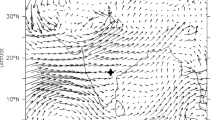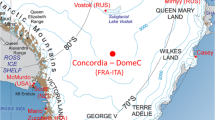Abstract
The characteristics and occurrence conditions of large-scale turbulence structures in the atmospheric boundary layer (ABL) are investigated above the suburbs of Kyoto City, Japan. An extensive observational set-up, including sonic anemometers–thermometers mounted on a tower, Doppler lidar, and radiosondes, was used to examine the turbulence structures and vertical profiles of the ABL downwind from the city. In near-neutral situations, large-scale turbulence structures with temporal scales of 100‒300 s are detected by the wavelet analysis in the time series of the streamwise velocity component measured in the surface layer. A shift towards unstable conditions is found to be favourable for the emergence of large-scale turbulence structures. Furthermore, the existence of these structures is seen to be related to the development of the ABL and the change of the turbulence situation in the daytime. On average at this site, wind speed in the lower ABL increases in the afternoon. From the intensive observations, we can infer that the downward transfer of momentum via turbulent mixing and other mechanisms extends a high-speed layer at the upper levels towards the surface. Intermittent occurrence of the further increase of wind speed in an interval of several tens of minutes is also found. Turbulence structures are clearly identified in these periods of higher wind speed.












Similar content being viewed by others
References
Arya SP (2001) Introduction to micrometeorology, 2nd edn. Academic Press
Cañadillas B, Westerhellweg A, Neumann T (2011) Testing the performance of a ground-based wind lidar system: one year intercomparison at the offshore platform FINO1. DEWI Magazin 38:58–64
Chen J, Hu F (2003) Coherent structures detected in atmospheric boundary-layer turbulence using wavelet transforms at Huaihe River basin, China. Boundary-Layer Meteorol 107:429–444
Collineau S, Brunet Y (1993) Detection of turbulent coherent motions in a forest canopy part I: wavelet analysis. Boundary-Layer Meteorol 65:357–379
Crawford KC, Hudson HR (1973) The diurnal wind variation in the lowest 1500 ft in Central Oklahoma: June 1966-May 1967. J Appl Meteorol 12:127–132
Feigenwinter C, Vogt R (2005) Detection and analysis of coherent structures in urban turbulence. Theor Appl Climatol 81:219–230
Foken T (2008) Micrometeorology. Springer-Verlag
Gao W, Shaw RH, Paw UKT (1989) Observation of organized structure in turbulent flow within and above a forest canopy. Boundary-Layer Meteorol 47:349–377
Gao W, Li BL (1993) Wavelet analysis of coherent structures at the atmosphere–forest interface. J Appl Meteorol 32:1717–1725
Garratt JR (1994) The atmospheric boundary layer. Cambridge University Press
Gottschall J, Courtney M (2010) Verification test for three WindcubeTM WLS7 LiDARs at the Høvsøre test site. Tech Rep Risø-R-1732(EN)
Grimmond CSB, Oke TR (1999) Aerodynamic properties of urban areas derived from analysis of surface form. J Appl Meteorol 38:1262–1292
Horiguchi M, Hayashi T, Adachi A, Onogi S (2012) Large-scale turbulence structures and their contributions to the momentum flux and turbulence in the near-neutral atmospheric boundary layer observed from a 213-m tall meteorological tower. Boundary-Layer Meteorol 144:179–198
Horiguchi M, Hayashi T, Adachi A, Onogi S (2014) Stability dependence and diurnal change of large-scale turbulence structures in the near-neutral atmospheric boundary layer observed from a meteorological tower. Boundary-Layer Meteorol 151:221–237
Hunt JCR, Morrison JF (2000) Eddy structure in turbulent boundary layers. Eur J Mech B 19:673–694
Hutchins N, Marusic I (2007) Evidence of very long meandering features in the logarithmic region of turbulent boundary layers. J Fluid Mech 579:1–28
Hutchins N, Chauhan K, Marusic I, Monty J, Klewicki J (2012) Towards reconciling the large-scale structure of turbulent boundary layers in the atmosphere and laboratory. Boundary-Layer Meteorol 145:273–306
Inagaki A, Kanda M, Ahmad NH, Yagi A, Onodera N, Aoki T (2017) A numerical study of turbulence statistics and the structure of a spatially-developing boundary layer over a realistic urban geometry. Boundary-Layer Meteorol 164:161–181
Jiménez PA, Vilà-Guerau de Arellano J, Dudhia J, Bosveld FC (2016) Role of synoptic- and meso-scales on the evolution of the boundary-layer wind profile over a coastal region: the near-coast diurnal acceleration. Meteorol Atmos Phys 128:39–56
Kaimal JC, Businger JA (1970) Case studies of a convective plume and a dust devil. J Appl Meteorol 9:612–620
Kaimal JC, Finnigan JJ (1994) Atmospheric boundary layer flows. Oxford University Press
Kim HT, Kline SJ, Reynolds WC (1971) The production of turbulence near a smooth wall in a turbulent boundary layer. J Fluid Mech 50:133–160
Kim KC, Adrian RJ (1999) Very large-scale motion in the outer layer. Phys Fluids 11:417–422
Kronland-Martinet R, Morlet J, Grossmann A (1987) Analysis of sound patterns through wavelet transforms. Int J Patt Recogn Artif Intell 1:273–302
Larsén XG, Larsen SE, Petersen EL (2016) Full-scale spectrum of boundary-layer winds. Boundary-Layer Meteorol 159:349–371
Lenschow DH, Wyngaard JC, Pennell WT (1980) Mean-field and second-moment budgets in a baroclinic, convective boundary layer. J Atmos Sci 37:1313–1326
Mahrt L (1981) The early evening boundary layer transition. Q J R Meteorol Soc 107:329–343
Mahrt L (1991) Eddy asymmetry in the sheared heated boundary layer. J Atmos Sci 48:472–492
Newsom R, Calhoun R, Ligon D, Allwine J (2008) Linearly organized turbulence structures observed over a suburban area by dual-Doppler lidar. Boundary-Layer Meteorol 127:111–130
Novitskii MA, Gaitandzhiev DE, Mazurin NF, Matskevich MK (2011) Turbulence characteristics in the coastal zone with breeze circulation. Russ Meteorol Hydrol 36:580–589
Park SB, Baik JJ, Han BS (2015) Large-eddy simulation of turbulent flow in a densely built-up urban area. Environ Fluid Mech 15:235–250
Roth M (2000) Review of atmospheric turbulence over cities. Q J R Meteorol Soc 126:941–990
Stewart ID, Oke TR (2012) Local climate zones for urban temperature studies. Bull Am Meteorol Soc 93:1879–1900
Stull RB (1988) An introduction to boundary layer meteorology. Kluwer Academic Publishers
Van der Hoven I (1957) Power spectrum of horizontal wind speed in the frequency range from 0.0007 to 900 cycles per hour. J Meteorol 14:160–164
Wang GH, Zheng XJ (2016) Very large scale motions in the atmospheric surface layer: a field investigation. J Fluid Mech 802:464–489
Yagi A, Inagaki A, Kanda M, Fujiwara C, Fujiyoshi Y (2017) Nature of streaky structures observed with a Doppler lidar. Boundary-Layer Meteorol 163:19–40
Yoshida T, Takemi T, Horiguchi M (2018) Large-eddy-simulation study of the effects of building-height variability on turbulent flows over an actual urban area. Boundary-Layer Meteorol 168:127–153
Acknowledgements
We would like to thank members of the Disaster Prevention Research Institute, Kyoto University, for their assistance in the maintenance of the measurement system and observations. This study was supported by the Japan Society for the Promotion of Science, Grant-in-Aid for challenging Exploratory Research, 24651208, 2012–2013, and Grant-in-Aid for Scientific Research (B), 26282107, 2014‒2016.
Author information
Authors and Affiliations
Corresponding author
Additional information
Publisher's Note
Springer Nature remains neutral with regard to jurisdictional claims in published maps and institutional affiliations.
Rights and permissions
About this article
Cite this article
Horiguchi, M., Tatsumi, K., Poulidis, AP. et al. Large-Scale Turbulence Structures in the Atmospheric Boundary Layer Observed above the Suburbs of Kyoto City, Japan. Boundary-Layer Meteorol 184, 333–354 (2022). https://doi.org/10.1007/s10546-022-00707-8
Received:
Accepted:
Published:
Issue Date:
DOI: https://doi.org/10.1007/s10546-022-00707-8




